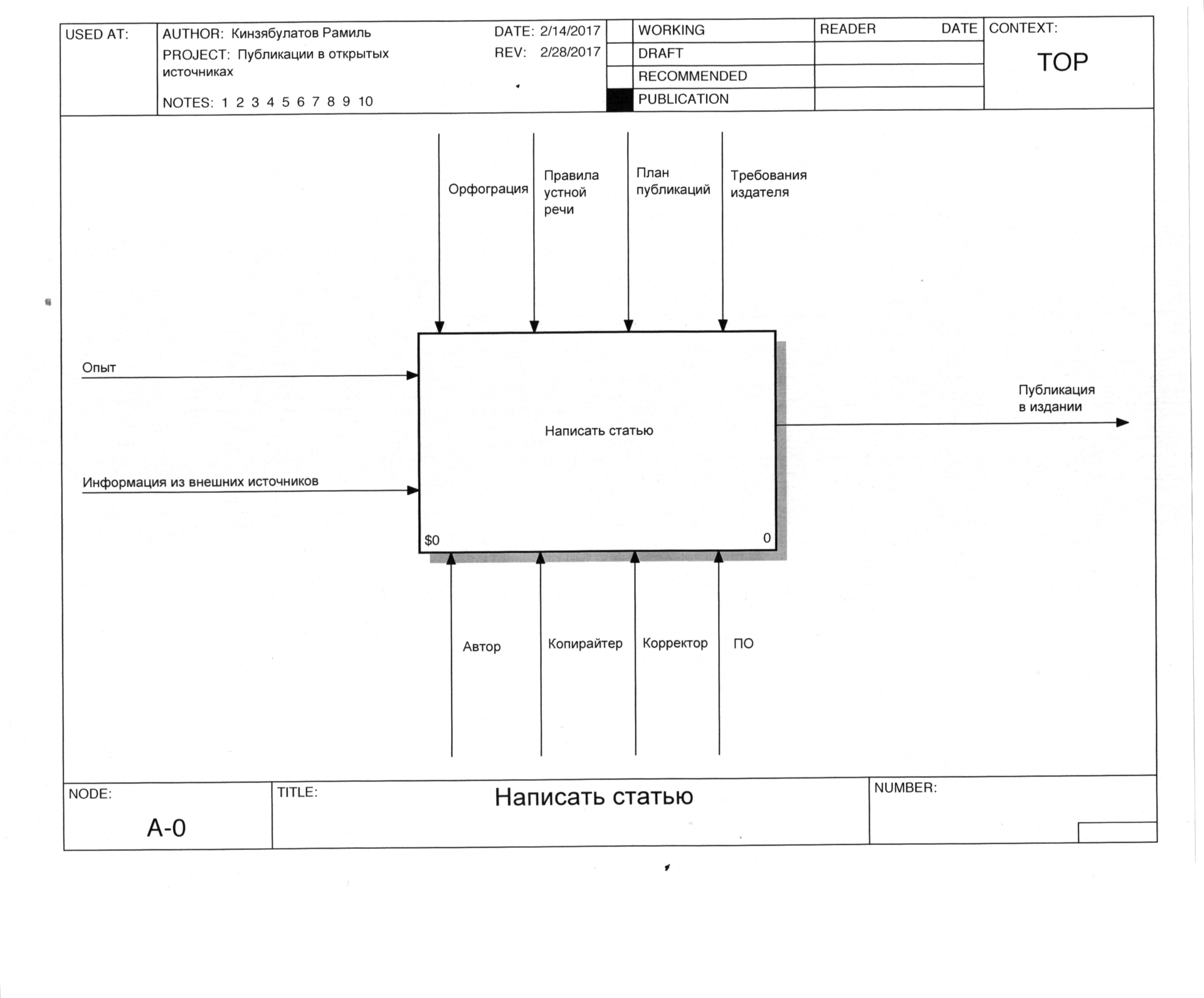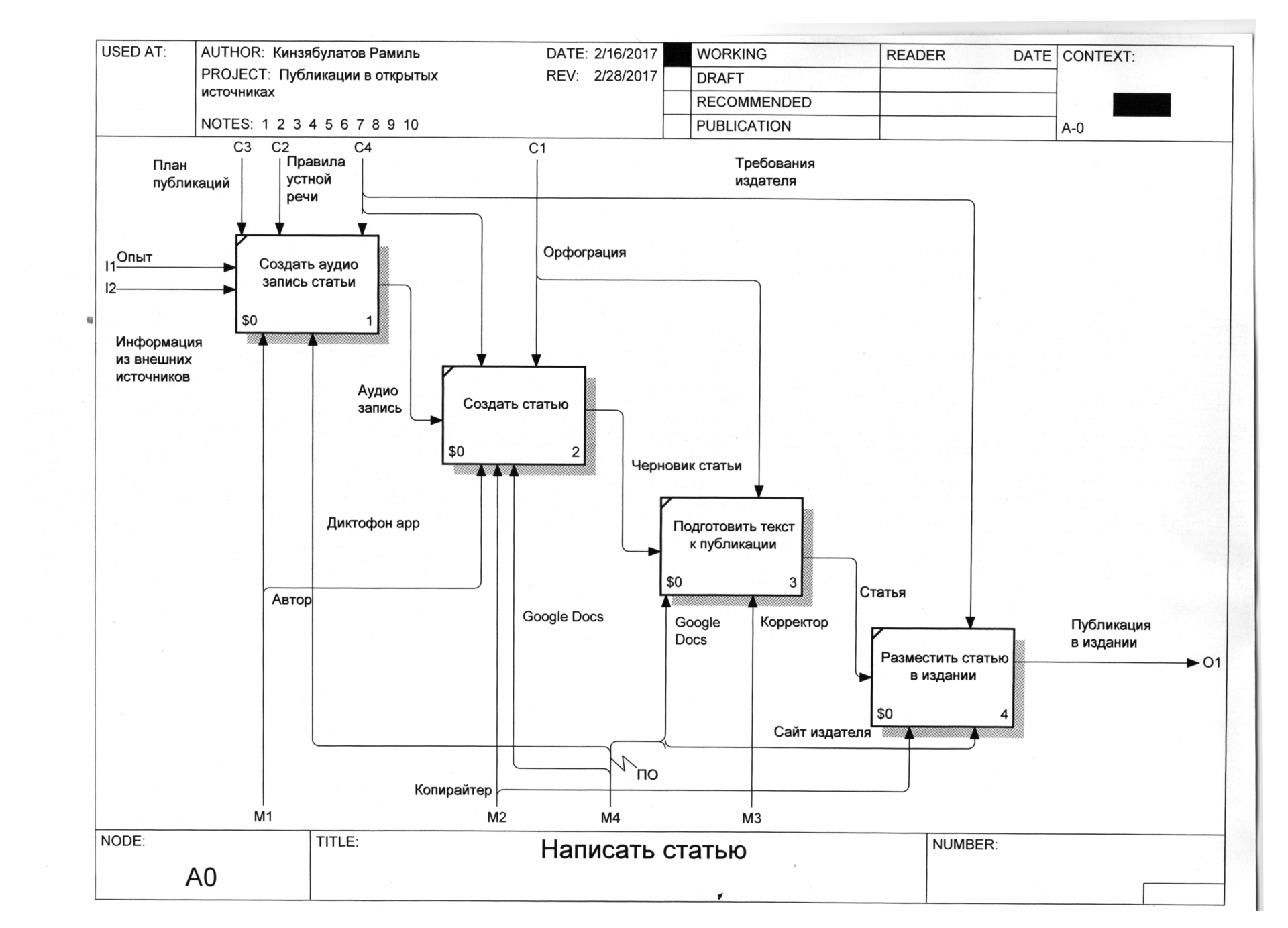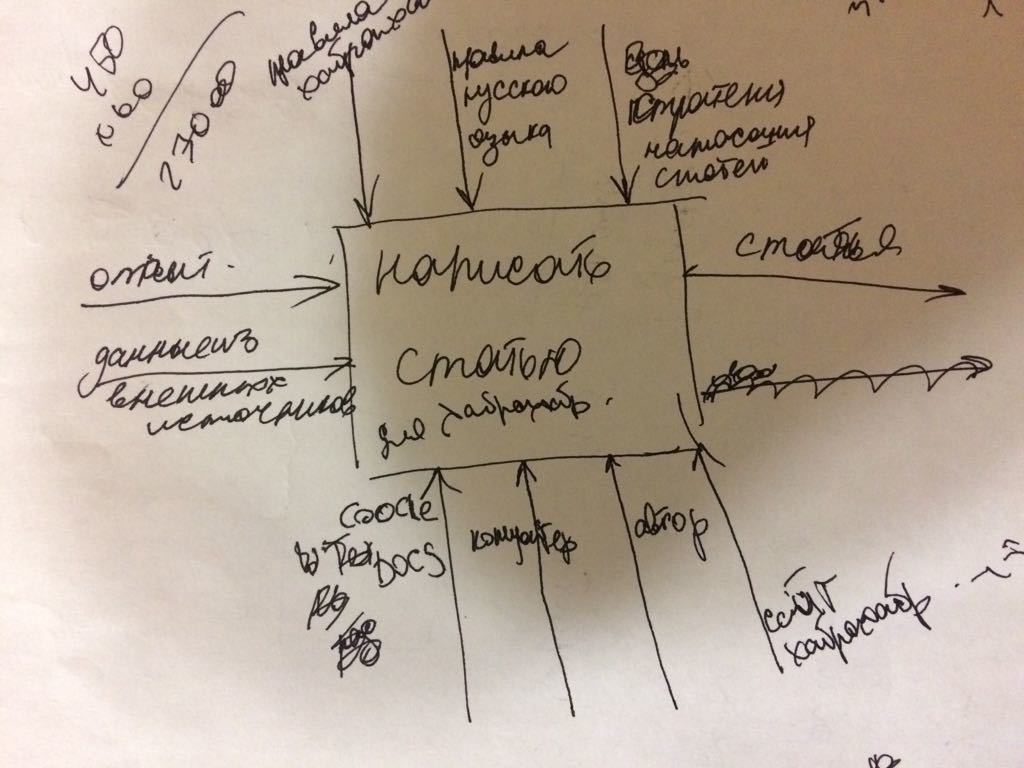Introducing IDEF0 Notation and Usage Example
One picture is worth a thousand wordsFolk wisdom

Often in my work there is a need not only to study and solve a specific problem, but to identify its location in the general model of the company. It’s not enough to understand that a certain unit is not working properly, it is important to understand how it interacts with others. Otherwise, it is impossible to identify all existing problems and choose the best method for solving the problem. And for this, it is required to study the work of the company and draw up its functional model.
Of course, in theory, the manager should have a functional model of the company’s work, and, it doesn’t matter, we are talking about the organization of the warehouse or the IT system from lead to application. But in reality it almost never turns out to be, and therefore, in the process of studying and searching for a solution to the problem posed by the client, I also create a functional model of the company or a specific process (function) myself.
A few words about the benefits of graphics
As you know, IDEF0 functional models are always graphic diagrams. They have their own characteristics and rules of compilation. We will talk about this a little later. And now I would like to give a couple of examples of the effectiveness of graphics. Why am I focusing on this? Most likely, after my statement about the need for a functional model of the company’s work, many people thought that this was all optional, and we could explain in words how this or that function works in the company. That's what I want to talk about.
And to begin with, we will make a short excursion into history. Let us return to the distant 1877, during the Russian-Turkish war. It was then that the polygraphist Sytin first applied graphics to the description of hostilities. Now all of this is familiar to us, when describing any battle, everyone has cards with arrows before their eyes that clearly show the course of the battle. And in those days, military operations were described in words. For every battle - many, many words. And in the end to understand what was happening, it was very difficult.
And therefore, Sytin’s idea was truly revolutionary - he began to print lithographic copies of maps indicating the fortifications and locations of military units. These cards were called “For Newspaper Readers. The allowance. " The idea turned out to be so relevant that the very first edition of the Benefits was sold out instantly. And then such applications were very much in demand. The reason is obvious. The graphics helped to understand what with the help of just words it was almost impossible to make out.
I can also cite a similar example of the helplessness of verbal descriptions from my own practice. One of my customers asked me to take up the implementation of an ERP system for his company. To the question whether they have any technical task, I received the answer: “Yes, there is. But it has 400 pages. ” At the same time, the client complained very much that my colleagues, whom he had contacted earlier, either refused the project altogether, or called clearly overpriced. After I saw that the technical task really had 400 pages, and it consists solely of a text description, I understood the reasons for the behavior of the developers. To read such a volume of text, to delve into it, to understand all the nuances only in order to understand the task and name the price - this is really very difficult.
I proposed an alternative option for this client - to describe everything that is possible graphically in the form of notations. Showed him modeling examples. As a result, they are now rethinking their wishes and designing technical specifications.
I also know many other examples when graphical modeling of business processes helped both my colleagues, business consultants and developers, and businessmen themselves.
Why is this important for my work?
My work is always related to making changes to the existing system. And in order to make changes and get the desired result, you need to study what exists now. And it doesn’t matter what we do - we set up or install a CRM system from scratch, create an effective ERP system, integrate various systems to improve automation in general. In any case, for starters, you need to get an idea of the existing scheme of work, and only after that you can propose some changes and think through options for solving the problem.
After studying the current state of things, I, like any other third-party specialist, create a commercial proposal in which I disclose as much as possible my vision of the current situation, as well as the actions that must be performed to solve the task, and, of course, the expected result.
Such reports on the survey of work are voluminous, they occupy more than one page, which, on the one hand, is necessary, and on the other hand, complicates the perception. At first, I, like many, thought that voluminous reports were good, because a person pays for work and you need to provide him with as much detailed information as possible.
→ An example of one of my reports in text form
In fact, it is important not to provide volume, but to convey the essence as quickly and fully as possible. Large amounts of text require time, which businessmen most often have very little. And the schedule allows me to reduce the volume of my proposal and clearly, in an understandable form to show the solution. As a result, my proposals were significantly reduced, graphics appeared in them, and decisions to start cooperation began to be made faster.
It is for this reason that I use visual models. As you know, one picture is worth a thousand words. And in the case of a description of business processes and options for modernizing the work of a business, this is true. And here IDEF0 notations work very well.
But for starters, let's look at the basic concepts of what notations are, why they are needed, what IDEF0 is, what are the features and advantages of this method.
What is business process description notation
Notation is a format for describing a business process, which is a collection of graphic objects used in modeling, as well as modeling rules.
In fact, notation is a special graphic language that allows you to describe the work of the company, clearly demonstrate the interaction between different departments, i.e. Describe business processes Notations can be used for process or functional modeling.
In general, notations can be called a programming language in business analysis.
What is IDEF0?
IDEF0 is a methodology of functional modeling (English function modeling) and graphic notation designed to formalize and describe business processes. A distinctive feature of IDEF0 is its emphasis on the subjectivity of objects. IDEF0 addresses the logical relationships between jobs, rather than their temporal sequence (workflow).Wikipedia
The IDEF0 standard was developed in 1981 in the United States by the Air Force Department for the automation of industrial enterprises. In the process of software development, developers are faced with the need to develop new methods for analyzing business processes. As a result, a functional modeling methodology IDEF0 appeared, in which special IDEF0 notations are used for analysis.
Functional company model
The functional model IDEF0 is a set of blocks, each of which is a “black box” with inputs and outputs, controls and mechanisms that are detailed (decomposed) to the required level. The most important function is located in the upper left corner. And the functions are interconnected with the help of arrows and descriptions of functional blocks. In addition, each type of arrow or activity has its own meaning. This model allows you to describe all the main types of processes, both administrative and organizational.
Arrows can be:
- Inbox - introductory, which set a specific task.
- Outgoing - outputting the result of activity.
- Controls (from top to bottom) - control mechanisms (regulations, instructions, etc.).
- Mechanisms (from bottom to top) - which is used in order to produce the necessary work.
It would be more accurate to call incoming and outgoing arrows input and output, since in English they are called Input and Output, respectively. But the features of the translation and the usual names already look like it happened. Nevertheless, for a correct understanding of the terms, it is important to remember their meaning in this case. This is also confirmed by the fact that this notation was created primarily for software development, and the terms should be translated more correctly from this point of view.
Arrows are signed using nouns (experience, plan, rules), and blocks are signed using verbs, i.e. they describe the actions that are performed (create goods, conclude an agreement, make shipment).
IDEF0 is a very simple and at the same time visual language for describing business processes. Using this standard, information can be transferred between developers, consultants and users. The standard is very carefully developed, it is convenient for design, universal. There are many tools for working with it, for example, VISIO, BPWIN, ERWIN, Bussines studio, etc.
In addition, using IDEF0 to create business models is not only convenient, it is also correct. This tool was developed for business analytics, it went through a long and thorough debugging and grinding. Therefore, using IDEF0 to create a functional model without errors is much easier than without applying this standard.
As you know, hammering nails is best done with a hammer. Of course, you can use other tools for this, but the hammer is the most functional and with its help it is easiest to hammer a nail accurately and accurately. So with the use of IDEF0 - this tool was created for functional modeling, and with it you can get the desired result much faster and more accurately.
An example of creating a functional model IDEF0
In order to understand how to work with functional modeling, I will give an example of the process of writing an article.
The main block is “Write an article”.

An example of a description of a top-level functional model.
Incoming arrows - “Experience”, “Information from third-party sources”. These are the introduction that you need to get started.
The managers for writing the article are “Publication Plan”, “Publisher Requirements”, “Russian Language Rules”.
And in the role of "Mechanisms" are the author, copywriter, corrector and software. In this case, the author creates an audio material in which he collects all thoughts and ideas that should be reflected in the article. A copywriter is a person who creates, based on the requirements of the publisher, the publication plan and the rules of the Russian language, a finished article. The corrector checks the material for errors. And software is the tools that all participants in the process use in their work.
Thus, I set the basic parameters of the process, its input, output, as well as everything necessary for a successful process. But this is only the basic framework of the process. This describes the general scheme of the company as a whole.
In fact, the process of creating an article, like any business process, can and should be detailed. To do this, I decompose the general block "write an article" into related elements.
In our case, the work is divided into 4 main stages:
- Prepare the audio.
- Prepare text
- Prepare the text for publication.
- Post an article in the publication.

An example of a description of a functional model of a business process of the second level.
The diagram clearly shows at what stage which control elements and which mechanisms are involved.
Thus, the author uses his knowledge and experience when creating audio, while he is guided by the publication plan and the requirements of the publisher. The copywriter receives an audio recording at the input, from which, following the rules of the Russian language, he creates the text. The corrector receives the text and checks it, also guided by the rules of the Russian language. To place an article in a publication, special software is required.
When creating a functional model, the key parameters are the goal and point of view. Based on them, the modeling of the same processes may look somewhat different. For example, in my case, the goal is to "talk about the process of writing an article." And the point of view of the copywriter is "writing and publishing an article from the point of view of the process leader."
So, if the same process were described from the point of view of a copywriter, then the experience and audio file from the author would be input. In this case, in this case, Experience would mean the experience of a copywriter, but not of a leader or author. Therefore, the first thing to determine when creating a model of a business process is to choose a point of view and clearly formulate a goal.
Such modeling is not only clear, but also very convenient for making effective management decisions. For example, in the business process described above, there are two separate specialists - a copywriter and a corrector. If I set the task to optimize the financing of the project, then thanks to the scheme I will immediately see where it is and how to do it. So, the copywriter and the corrector use approximately the same rules, but the copywriter receives the audio, and gives the result in the form of text, the corrector also receives and gives the text. Therefore, if necessary, I can, for example, offer half the price of the corrector’s duties to the copywriter. So I will save money and time on the interaction of different specialists. Of course, I understand all the merits of proofreaders and why it is better to work with individual specialists. But I remind you - I have a task: cost optimization.
Without such a visual tool, it would be more difficult to determine which of the blocks can be removed and, thus, optimize the work.
How to create IDEF0 notations
There are many different software products that you can use when creating notations. Some are created specifically for functional modeling, others are designed for any work with graphic elements. Where and how you will build these models is up to you.
 I personally think that in the first stage there is nothing better than plain paper, a simple pencil and an eraser to make corrections in case of errors.
I personally think that in the first stage there is nothing better than plain paper, a simple pencil and an eraser to make corrections in case of errors. In order to create a notation of existing business processes, i.e. describe how the company is working now, it is necessary to study the principles of work. An external specialist (consultant, developer) conducts an interview for this. At the first stage, the head of the company answers questions, then in the process of detailing the notation, interviews are conducted with the employees responsible for the various stages of work.
It is important to understand that as a result, 2 notations are required. The first will display business processes as is. You create it based on interviews and coordinate each detail with company employees and the head. It is very important that your vision of existing processes coincides with reality, and this is why confirmation at all levels is required.
The second notation is “as it should be.” It is created on the basis of the first and those changes that you propose to make to the structure of work to optimize and automate the work of the company as part of the task.
IDEF0 standard requirements
The basic requirements of the IDEF0 standard, in principle, I described above and showed an example.
- In the upper left corner is always the main element.
- All elements must have incoming and outgoing arrows, since for execution you need to get something at the input (order, task), and after processing the output, you need to transfer the finished product. Incoming arrows are always on the left, outgoing arrows are on the right.
- Above are the control elements, below are the mechanisms necessary to complete the process.
- If several blocks are located on one sheet (screen), each subsequent one is located to the right and lower than the previous one.
- It is necessary to strive to create schemes in such a way that the intersection of the arrows is minimized.
The IDEF0 standard also includes generally accepted notation, rules, requirements for diagram blocks, and has its own semantics. You can familiarize yourself with them in the document "Methodology of functional modeling IDEF0" .
Common mistakes
Functional modeling is performed using a variety of tools, including those not intended for modeling. In the latter case, there is no error checking and limitations of the standard. The desire to increase visibility and lack of experience often ends in errors.
Using different colors
All elements in the diagram are equally important. In functional modeling, there are no more or less important elements. The disappearance of any will lead to disruption of the process and production defects.
Often when modeling on paper or in various programs, users try to increase visibility through the use of different colors. This is one of the most common mistakes. In fact, the use of multi-colored arrows and blocks only introduces additional confusion and also distorts the perception of the circuit.
Your model should be read in black and white, without any additional color solutions. This approach simultaneously helps to avoid misunderstandings and disciplines the creator of the model, as a result, the readability and literacy of the model increase.
Too many blocks
When compiling a model, they often try to display on one sheet all the nuances of the company’s work with all the details. The result is a very large number of blocks with a large number of control arrows. Readability is lost.
The best option is a granularity sufficient to understand the issue, and nothing more. Detailed details of the work of each unit or even an employee may be disclosed when choosing a detailed view of a process. And such a structure is created only if it is really necessary for work or decision making.
Violation of the structure when making adjustments
Carefully ensure that there is no confusion or processes without incoming, outgoing and other important elements. For example, if in the above example, I consider it necessary to shift the point of view to the copywriter, I will remove the author from the scheme. And then the control elements “author’s experience and third-party sources”, as well as the publication plan, become unnecessary. After all, the author uses them. The copywriter works with the audio file. And if they remain in the general scheme, then during the details they will lead to incomprehensible where and introduce confusion.
Similarly, if I decide to add some kind of block, it is important to make sure that it also has all the necessary attributes. Carefulness is very important here, since when modeling complex business processes, changes in one part of the model can lead to changes in another. They must be contributed.
Rules for the names of controls and blocks
It is important to remember a simple rule: control arrows are called nouns, blocks are called verbs. This is accepted in the IDEF0 standard, and this approach helps to avoid confusion and errors.
Most often, mistakes are made when naming blocks. For example, instead of “Create an article” they write “Create an article”. Blocks in this approach are actions, and therefore they should always be verbs.
Benefits of using IDEF0
- The very first benefit is obvious - it's visual. You yourself begin to understand how this or that system works, and you can also clearly explain where in this system there are “thin spots” and how your decisions will help get rid of them.
- Mutual understanding and lack of discrepancies. When discussing the work of a company using a functional model, you have intuitively clear and intuitive task blocks with control elements. In addition, functional modeling involves the creation, if necessary, of a glossary in which symbols and terms are disclosed. As a result, you and your client, manager, and other employees speak the same language when discussing a problem.
- Simplicity and high speed of model creation. Of course, learning how to model is not as easy as it sounds. After all, a scheme is, in essence, an overdense presentation of information, which is very good for understanding, but a special approach is required to implement such a presentation. The analyst’s brain appears in this case as a very powerful press on the one hand, and a filter on the other. But with experience, this process becomes very fast. As a result, you get a tool that will help you figure out what is happening in a particular system, and with the help of a visual aid created in a short time, illustrate important points to colleagues or customers.
- Discipline and lack of errors. The IDEF0 standard requires strict frameworks and rules. This approach disciplines, and the habit of acting within the framework of the standard helps to avoid errors by inattention. Any violations of the standard become immediately noticeable.
What is the difficulty of using IDEF0
It is important to understand that only in the simplest cases, two business analysts will create exactly the same functional models to describe the work of the company. Any model is a reflection of the analyst’s experience, the depth of understanding of the business, which he seeks to describe, as well as, in some way, his personal point of view on this business. Those. a person develops a business model from the point of view of the leader, as if that leader was he.
At the same time, I believe that a business analyst is not quite a profession, every business leader or developer of some systems is engaged in business analytics, who analyzes the business and seeks to build the most effective system. It is for these people and for these purposes that the IDEF0 tool is intended.
Therefore, it is very important when compiling a functional business model “as is” to constantly consult with the head of the company so as not to make mistakes that automatically entail errors at the stages of decomposition. Also, in subsequent stages, additional coordination with the heads of structural divisions and employees may be required. Only if your functional model “as is” will truly reflect the real state of things, can you make any changes and suggestions. And to achieve high-quality results in such work, first of all, practical experience and knowledge of the features of a particular type of business are required.
More articles on this topic:
- What is a business process and description of a business process
- Business modeling. Key Approaches
- Understanding the concept of BPM. What is business process management
- Brief BPMN with an Example
- What is BPMS?
- Using GAP analysis to identify and coordinate project tasks
Also, currently I am preparing to publish a book and an online course in which I will describe in detail my own vision of the process approach to business, as well as my own practical experience in the field of functional and process modeling. Everyone can sign up for a notification about the release of a new book via the other news link .

